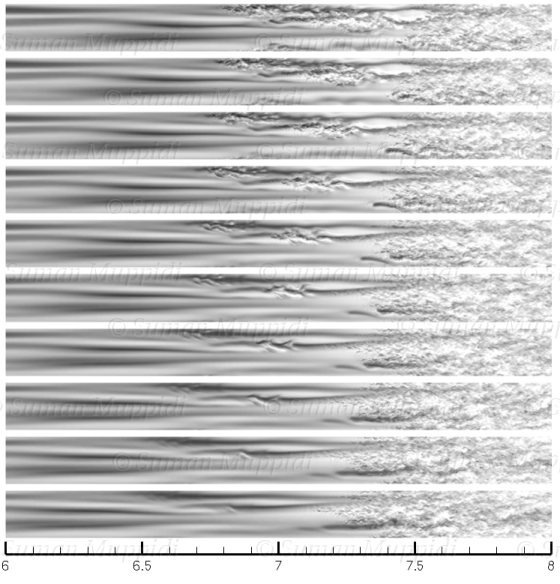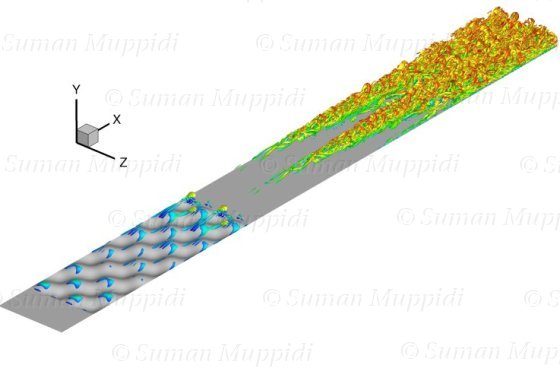Suman Muppidi
Research Associate
Aerospace Engineering and Mechanics, University of Minnesota
Transition in high speed flows
Prediction and understanding of compressible high speed flows is essential for the development of high speed vehicles and engines. These flows are frequently turbulent or transitional, and exhibit increased rates of heat transfer and skin friction in the boundary layer. The process of transition is very sensitive to disturbances, numerical errors, surface roughness and geometric imperfections, making reliable computations very challenging. Even as the flow becomes turbulent, it involves a wide range of scales of motion, and accurate computations are far from being straight-forward. This page presents some of my work on high speed transition.Transition due to boundary perturbation

Figure : Supersonic boundary layer transition due to periodic blowing/suction.
In this study, laminar flat-plate boundary layer flow is continuously perturbed at the wall by small amplitude blowing/suction which causes the flow to transition, and become turbulent. Figure shows a time sequence (from bottom to top) of snapshots of the flow parallel (and close) to the wall. The flow is from left to right. Boundary perturbations are applied between x=4.5 and 5.0 (to the left of the picture), and the flow becomes turbulent some distance downstream. Note that the location of transition is not fixed in space, and shows a significant variation with time.
Related Publication
- Suman Muppidi & Krishnan Mahesh 2010
DNS of Transition in Supersonic Boundary Layers
Proceedings 40th AIAA Fluid Dynamics Conference and Exhibit, Chicago, Illinois
AIAA paper 2010-4440.
Transition due to distributed roughess

Figure : Supersonic boundary layer transition due to distributed roughness.
In this study, direct numerical simulations are used to study transition of a Mach 2.9 boundary layer due to a distributed roughness region. Roughness modifies the near-wall velocity/vorticity field and creates a shear layer. As the vortices travel downstream, their interaction with the shear layer causes the flow to transition. Figure shows the roughness generated vortices, as well as the hairpin vortices in the turbulent region.
Related Publications
- Suman Muppidi & Krishnan Mahesh 2012
Direct numerical simulations of rougness-induced transition in supersonic boundary layers
Journal of Fluid Mechanics, vol. 693, pages : 28-56.
- Prahladh Iyer, Suman Muppidi & Krishnan Mahesh 2012
Boundary layer transition in high-speed flows due to roughness.
Proceedings 50th AIAA Aerospace Sciences Meeting, Nashville, Tennessee
AIAA paper 2012-1106
- Prahladh Iyer, Suman Muppidi & Krishnan Mahesh 2011
Roughness-induced transition in high speed flows
Proceedings 49th AIAA Aerospace Sciences Meeting, Orlando, Florida
AIAA paper 2011-566
- Prahladh Iyer, Suman Muppidi & Krishnan Mahesh 2010
Transition of Hypersonic Flow Past Flat Plate with Roughness Elements
Proceedings 40th AIAA Fluid Dynamics Conference and Exhibit, Chicago, Illinois
AIAA paper 2010-5015.